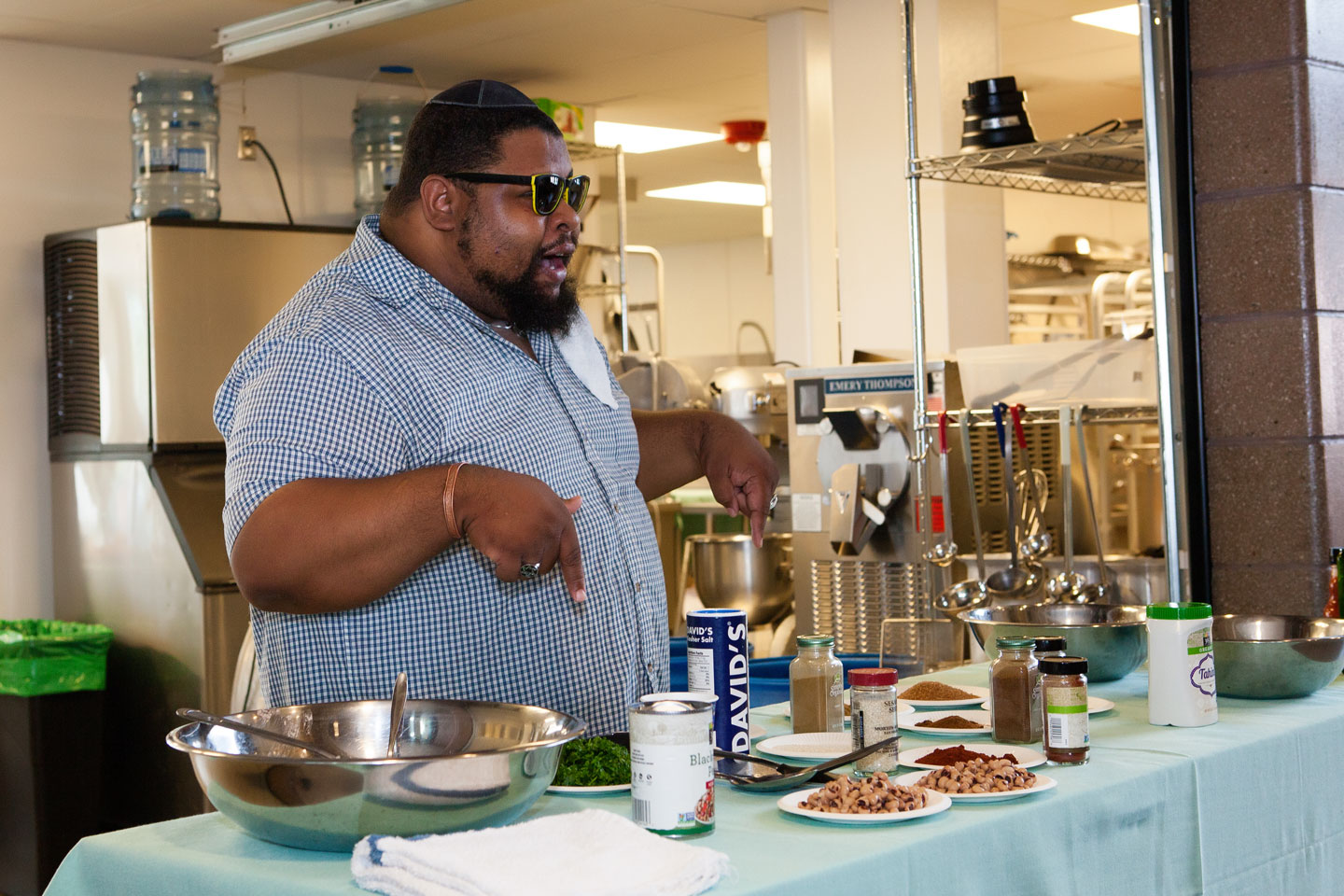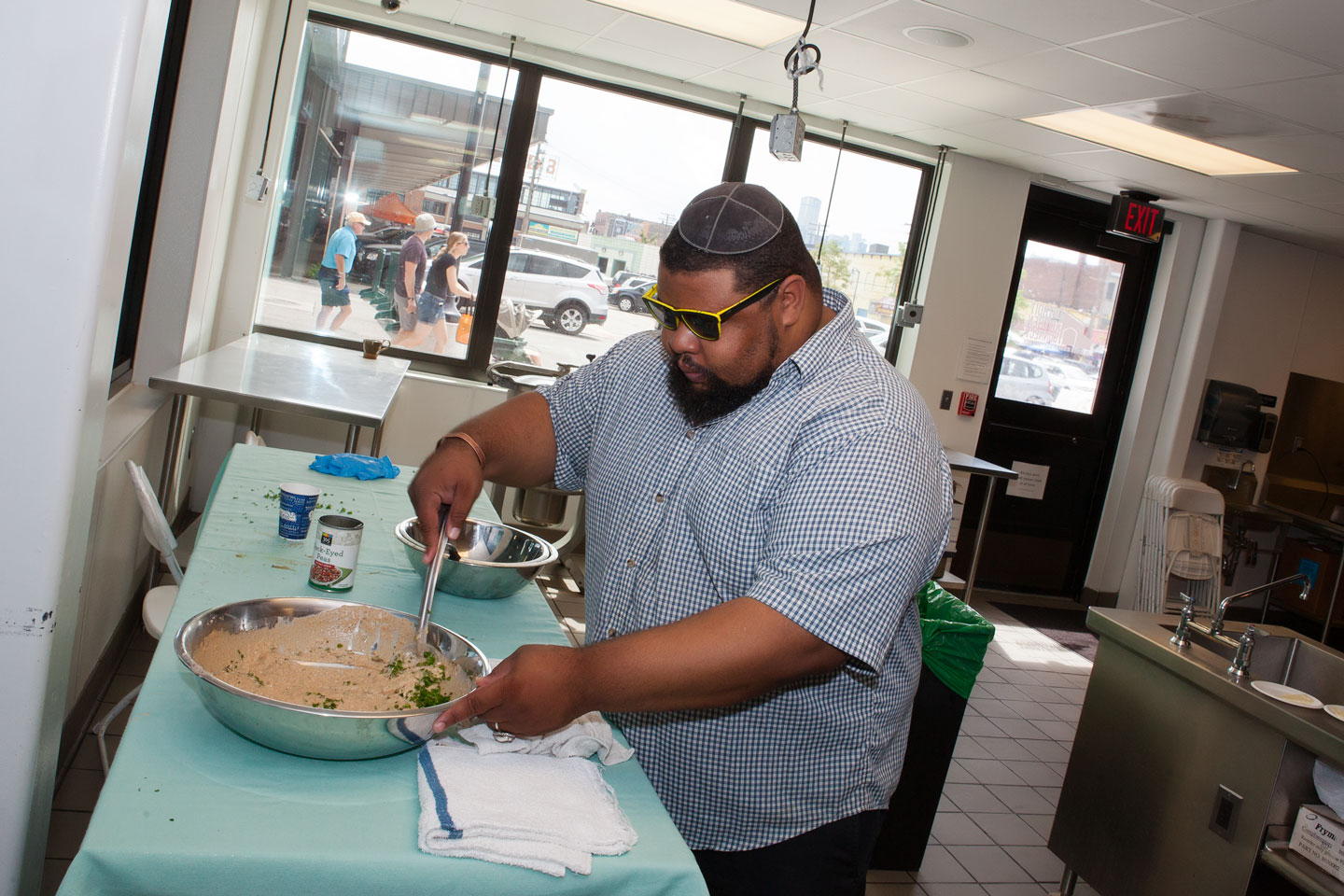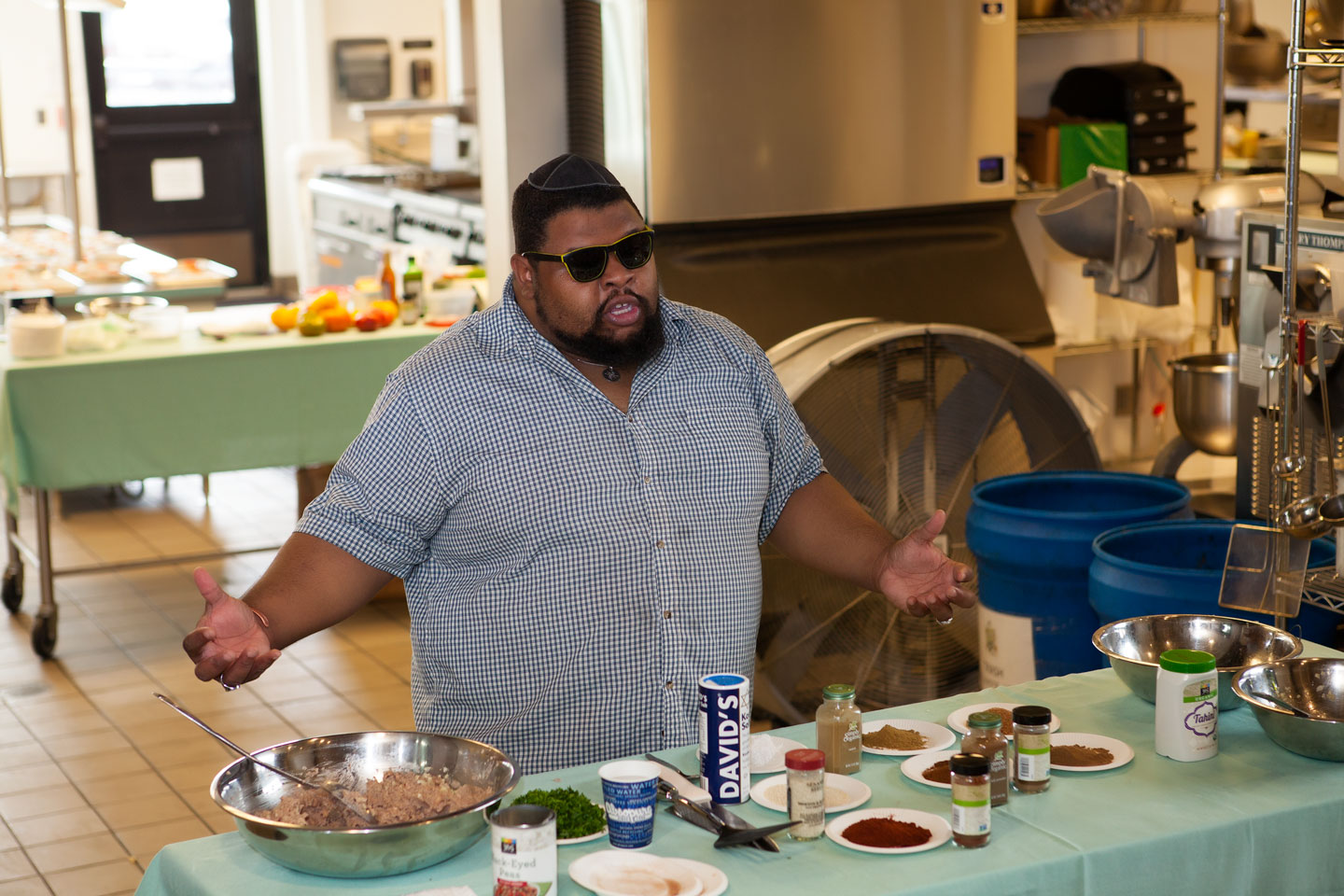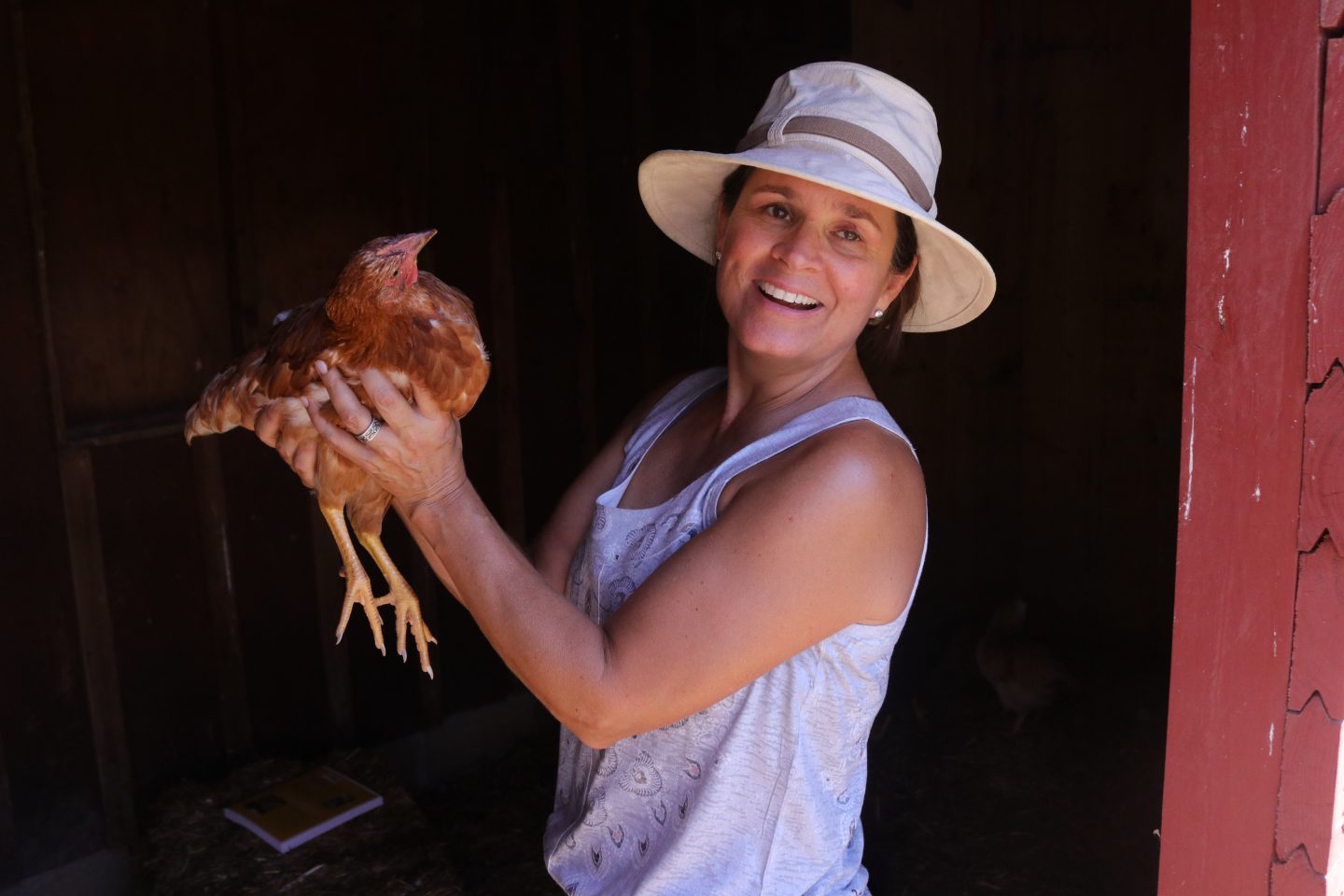Michael Twitty: A Kosher Soul
By Vivian Henoch, Editor myJewishDetroit
September 29, 2016
by Vivian Henoch
Chef Michael Twitty may not be a Jewish household name . . . yet. But mark these words (or Google):
Kosher/Soul – his brand
Afroculinaria – his blog
The Cooking Gene – his book, soon to be published by HarperCollins
“I don’t believe in “race,” except for the human one.” -Michael W. Twitty
An inspired food writer, independent scholar, culinary historian and TED speaker – named in Southern Living as one of 50 People Who Are Changing the South in 2015 – Michael Twitty, 39, makes no bones about the complexity of his identity. Black, devoutly Jewish and openly gay, Twitty is a man with a mission on a journey to bring our diversity to the table and demonstrate how our food connects us. And, indeed, with his creative hybrid specialties like black-eyed pea hummus, mac ‘n’ cheese kugel and matzo ball gumbo, Twitty continues to carve a unique culinary niche that merges the elements of African American/ Southern Antebellum and Jewish cuisine.
Why black-eyed pea hummus?
Twitty explains: “Today, hummus is emblematic of the Middle East. And black-eyed peas are emblematic of soul food. But the first things you should know about black-eyed peas is that it’s a food we share. By their roots in antiquity, Jewish food and African American Diaspora food have a lot in common and those similarities are based on the fact that we are both migratory people who had often been at the same places at the same times.”
On Sunday, August 28, 2016, nearly 5,000 people from neighborhoods across Metro Detroit gathered in Shed 5 at the Detroit Eastern Market for Michigan’s first Jewish Food Festival, presented by Hazon Detroit. Michael Twitty was the headline speaker on Kosher Soul:Black and Jewish Identity Cooking. For those who missed his outstanding presentation (and the opportunity to sample his recipe for black-eyed pea hummus), here are the highlights:
Twitty: on His Jewish Journey

Long before he was a celebrated chef, Twitty was a Hebrew teacher. Some of his students are in graduate school now, he tells us, but when he first started 14 years ago, he faced all kinds of “questions of validation.”
“I was the yid of a different color – not the old Israeli lady, not the former rabbi from the X-congregation from a thousand miles away – I was young, male, African American and of Jewish descent by conversion. They learned quickly not to put their 7th grade stuff over on me, and I loved the challenge of teaching students across all streams of Orthodox, Conservative, Reconstructionist, Renewal and Reform Judaism.”
Twitty describes growing up just outside Washington, DC – not far from the Jewish community. “We were neighbors, there were no surprises,” he says. “It was nothing for me to go and build and play in a sukkah when I was little.” In his mother’s kitchen, challah was a weekend staple, as the only bakeries open in the neighborhood on Sunday were Jewish.
Twitty was 7-years-old when he saw the film adaptation of Chaim Potok’s The Chosen on TV. “I was fascinated by the movie and thought, wow, I can relate to this spiritual thing. So I told my mother I was Jewish. She said, fine, and let me be Jewish for one week. I made a baseball cap into my pseudo kippah, and wore it for a week; I refused to eat bacon for breakfast; I refused to read the new testament. After my week as a Jew, my mother said she was very impressed and I sat there very smugly, until she mentioned the thing that doctors do to all baby boys, and I said ‘yes?’ And my mother slammed her hand down on the table as hard as she could and, with a smile, she said, ‘Well, they’ll have to do it to you all over again!’ . . . And that’s how I immediately stopped being Jewish after a successful week of being Jewish as a child.”
Twitty’s immersion into Judaism would come again after college. Working as an intern at the Smithsonian, developing programming for “Jewish Foodways” for the Smithsonian Folklife Festival, he met Jewish cookbook author Joan Nathan. In search of a recipe, she sent him to Magen David Sephardic Congregation in Rockville, Maryland, where the first person he met was this 6-foot-4 young African American man about his age – and he took it as a sign and became part of the congregation.
“I remember the second or third week, when someone threw a tallit (prayer shawl) on me. This was not traditional, but clearly it was the welcome of Sephardic hospitality. I was there to learn. And so they would help me word-by-word to read the siddur (Hebrew prayer book) – and the kids got to know me and I started teaching, and then they took me to the mikvah — it was beautiful, I got the candy thrown at me, the rosewater, the whole deal at the age of 25. And, in the process, I learned a lot about Sephardic and Mizrachi food traditions – in addition to what I already knew about traditional European food.
Twitty: On Making Hummus (and Peace) in Israel
“You know the stupidest thing you could ever do? Go to Jerusalem and try to teach Israelis and Palestinians how you make hummus!!”

“I held a cooking class at Abraham Hostel and it was very funny: I had on one side of the room Israeli Arabs and Palestinians and on the other side Jews! Israeli Jews.
“I look at them and I see they’re ready for me to start something. And so, Orthodox Jewish guy and Palestinian guy both get up at the exact same time and ask the exact same question: Tell me who does hummus belong to?
“So I look around the room, I wait, 10 seconds go by. (There were people in the hospitals at the other side of Jerusalem, waiting to see Hashem – their ears are burning in anticipation for what I am about to say! There are people on the other side of East Jerusalem– they have sounded the horns at the mosques to hear what I’m about to say. The entire Kotel has stopped praying . . . because they all want to hear the answer. Who owns hummus?
And I look at the anxious faces in the room and I say, “Is hummus Jewish?”
Yes!
And half the room grumbles.
“Is hummus Arab?”
Yes!
There’s a yay – and the more grumbles in the other half of the room.
“Does hummus belong to neither of you?”
Yes!
Huh?
And No! I say to them ‘no.’ Hummus belongs to a Mesopotamian woman – neither Jewish, nor Muslim—who had hungry kids. And she had some chickpeas and some garlic—she mashed them together and said, here, eat!
That’s how hummus started. And because you are her children – you are her mishpacha (family) – hummus brings you together more than it separates you – that’s how this works. And with that, I got a round of applause. And then, there was quiet, and in peaceful accord, they started mingling, sitting with each other — and that taught me something else about hummus: if you really want to make peace, never make your own hummus with Israelis and Palestinians. Because they are going to argue with you about their own recipe every step of the way!”
Twitty: On Black-Eyed Peas as a Jewish Tradition
Did you know? Black-eyed peas are a traditional Rosh Hashanah food included in the ancient Talmudic menu. Similar to the Southern tradition of eating black-eyed peas as a good luck food, some Sephardim eat black- eyed peas for Rosh Hashanah, as they are believed to increase one’s mitzvot for the year to come.
So, l’shana tova, and let’s eat already!
For more on Michael Twitty, visit online www.afroculinaria.com and www.theweiserkitchen.com; Michael W. Twitty on Facebook or @Koshersoul on Twitter.
Michael Twitty’s guest appearance at the Michigan Jewish Food Festival was made possible by Hazon Detroit, with the support of the William Davidson Foundation, the D. Dan and Betty Kahn Foundation, the Ben N. Teitel Charitable Trust, The David Farber Family Foundation and the Jewish Federation of Metropolitan Detroit.




